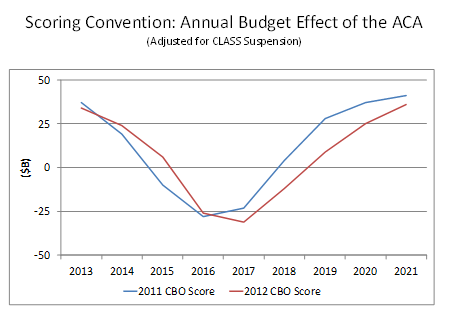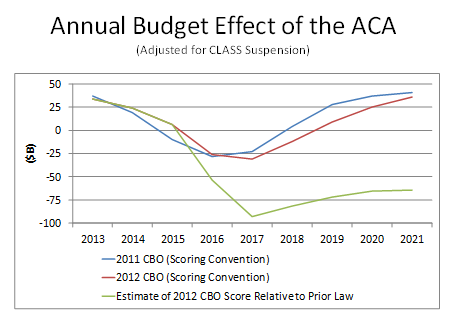- | Healthcare Healthcare
- | Expert Commentary Expert Commentary
- |
Yet Another Fiscal Turn for the Worse: Understanding the CBO Re-Score of the 2010 Health Care Law
The Congressional Budget Office (CBO) has just published, in two reports, its updated score of the 2010 health care law. The new score is bad news from almost any vantage point. CBO’s fiscal evaluation of the law is worse than before, even though the number of people receiving health insurance coverage is now projected to be fewer.
This article was originally published in e21
The Congressional Budget Office (CBO) has just published, in two reports, its updated score of the 2010 health care law. The new score is bad news from almost any vantage point. CBO’s fiscal evaluation of the law is worse than before, even though the number of people receiving health insurance coverage is now projected to be fewer.
Below I present the key features of the latest CBO report.
Background/Where We Were Before: The CBO update was prompted by the recent Supreme Court ruling upholding the constitutionality of most but not all of the 2010 health care law. The ruling selectively struck down the law’s provision allowing the federal government to enforce, by withholding existing funding, a compulsory expansion of Medicaid by the states.
Prior to CBO’s latest report, their last operative score was conducted in early 2011. There are at least six critical points to understand about that 2011 score:
1) CBO’s 2011 score found that repeal of the health care law – relative to a specific budget baseline scenario -- would increase federal deficits by $210 billion over ten years.
2) That’s another way of almost saying – but not exactly – that the health law reduces federal deficits by $210 billion over ten years. CBO cautions that the two scenarios aren’t exact opposites because repealing some provisions retroactively would come with a cost, among other reasons. We can thus think of the 2011 CBO score as finding that the health care law improves federal finances by $210 billion at best, or put more precisely, relative to repeal. Rather than repeat this qualification throughout this article, all future references to the effect of the 2010 law here will be given relative to repeal.
3) That 2011 score was conducted prior to the suspension of the law’s CLASS program provision. Taking the suspension into account reduced the law’s positive 2011 score to about $123 billion over ten years.
4) Perhaps most importantly, the official CBO score was under a hypothetical baseline scoring convention that it is obliged to use. Basically, CBO assumes that whether the health care law stands or is repealed, Congress will make certain other changes to existing law. This is different from comparing the health care law relative to actual prior law. I published a paper earlier this year explaining the difference. As my paper showed, the health care law will increase deficits by more than $340 billion over ten years relative to actual prior law.
5) The ten years covered in the CBO 2011 score were the years 2012-21 inclusive.
6) In that 2011 score, CBO anticipated that by 2021 33 million people would gain coverage under the law: 23 million from new health insurance exchanges, plus 18 million from Medicaid, minus a 7 million decrease in coverage by other sources (plus rounding errors).
All of the above describes where we were coming into this year. Now for how the latest score has changed the outlook.
CBO’s Latest Score, Under the Standard Scorekeeping Convention, is Worse: CBO now finds that relative to the baseline the health law reduces deficits by $109 billion over ten years: less than the 2011 score of $123 billion. BUT – they aren’t the same ten years. CBO’s latest score covers 2013-22, whereas the previous score covers 2012-21. This matters because in the latest score 2022 is a particularly good year for the health care law – a positive $44 billion. Through 2021, the positive score is now only $65 billion. This is barely half as good as the $123 billion anticipated last year.
The graph below compares the years that the two most recent scores both project: 2013-21. On this graph, up is good and down is bad. Up signifies that the law improves the budget outlook, down that it worsens deficits.
The two scores are qualitatively similar. They both show the health law worsening the deficit in the middle of this decade and improving matters beyond. But it’s also clear that the budget impact of the law in the latter part of the window is now projected to be less favorable, even under this highly flattering scoring convention.

As has been explained elsewhere, this scoring method is problematic because it compares legislation with a hypothetical budget baseline scenario (one in which Congress departs from historical precedent and changes the law to allow Medicare to spend after its trust funds are depleted) rather than to actual alternative law. Relative to actual repeal, the 2010 law has clearly caused a fiscal worsening. CBO’s latest update suggests that the fiscal worsening is still at least $340 billion through 2021, though a fully precise estimate cannot be made without additional published detail on how the law’s Medicare savings would be allocated between the program’s trust funds.
Again, on the next graph up is good for the budget, and down is bad. The graph shows that relative to prior law the 2010 health law worsens the federal deficit, even though it appears to reduce deficits under Congress’s scoring conventions.

Some news reports say that the latest CBO score finds lower costs for the law as a whole. That is not how I read CBO’s latest reports. The press appears to be seizing on CBO’s having reduced the projected cost of one particular set of provisions of the law(the coverage provisions). But CBO’s assessment of the total cost of the law has gone up, in part because their estimates of other provisions’ cost savings have been reduced. In Table 2 of the latest score, total outlays under the law are projected to rise by $890 billion through 2022, or $771 billion through 2021. Last year the projection was $604 billion through 2021. Even after adjusting for the subsequent suspension of the CLASS program (narrowing the difference by $86 billion), this is a substantial increase in projected spending for the health law as a whole.
And once again, this is simply the number resulting under the scorekeeping convention. In comparison with actual prior law, the cost increase is much higher. My study based on 2011 projections previously estimated that federal outlays would increase by over $1.15 trillion through 2021. CBO’s latest report suggests this should be increased to between $1.19 and $1.2 trillion, though again a precise estimate cannot be made without additional detail on the allocation of the Medicare savings.
Costs Per Person Have Gone Up: One thing there is no disagreement about is that costs per person under the law have gone up, as I predicted in my last article.
Compared with CBO’s 2011 projections for 2021, CBO now projects that 3 million fewer people will have coverage under the law (a coverage expansion of 30 million rather than 33 million). This is in large part because it now sees 11 million being covered under Medicaid (as opposed to the 18 million projected last year). Some of this reduced Medicaid participation would be made up by greater participation in the exchanges (25 million, vs. last year’s projection of 23 million).
I do not recommend that lawmakers make the number of covered individuals the sole criterion by which the success of reform is measured; doing so only leads to higher federal costs. Nevertheless, for the law to now be expected to cover fewer people while having a worsened financial impact is clearly bad news.
Cost Projections Now Have Greater Uncertainty and Downside Risk: The 2010 health care law directs states to expand Medicaid coverage up to 133% of the federal poverty line (effectively 138% because of a 5% income exclusion). Per the Supreme Court, however, the federal government cannot force the states to do this. Individuals from 100% to 400% of the poverty line are eligible for the health exchanges (and their federal subsidies) if they are not otherwise eligible for Medicaid, among other conditions. Thus, much of the financial impact of the law hinges upon how much the states decide to expand Medicaid.
If the states don’t expand coverage at all, then fewer people will be covered and costs will be lower than CBO projects. If instead all the states cover individuals under Medicaid up to exactly 100% of the poverty line, the total costs of the law will likely rise significantly as more individuals over 100% receive comparatively generous federal subsidies through the new health insurance exchanges. No one knows what will happen.
CBO takes pains in this latest report to stress the uncertainty of these projections. This uncertainty is critical because CBO’s latest analysis is actually based on lower projected costs for the coverage expansion even though its estimate of the law’s overall finances has gotten worse. CBO anticipates that as a result of the Supreme Court ruling, some people won’t be covered under Medicaid and will go to the exchanges instead (increasing federal costs), whereas others won’t be covered at all (reducing federal costs by even more). So while per-capita costs go up, CBO projects that the aggregate cost of the coverage expansion in isolation is now lower than before. Yet, despite this anticipated source of fiscal improvement, the law’s overall fiscal effects are still worse than previously projected.
Why are they worse? A number of reasons. Beyond the already-mentioned suspension of CLASS, CBO now anticipates that the Medicare cost-containment provisions of the ACA will produce less savings than originally estimated. Moreover, one of the law’s revenue provisions has already been repealed. There are other factors as well, but suffice it to say that the law’s overall finances look weaker than they originally did.
CBO does its best to predict a general trend of behavior of the states, but all it can do is guess. Somewhat ominously, CBO’s reportrecognizes a point that I made in my last article: “some states will probably seek to implement a partial expansion of Medicaid eligibility to 100 percent of the FPL, because, under the ACA, people below that threshold will not be eligible for subsidies in the insurance exchanges while people above that threshold will be if they do not have an offer of affordable coverage from an employer and meet other eligibility requirements.” Quite so. If many or most states go that route, the fiscal worsening under the law may well be worse than the >$340 billion over the next ten years that one derives from the CBO projections.
Conclusion: Once again, the latest CBO update shows worsened finances for the 2010 health care law, despite the use of assumptions regarding state behavior that make the projections more fiscally optimistic. Using the scoring convention that shined such a flattering light on the law at the time of its original passage, the law now looks less favorable. Total costs for the law, despite the first day’s press reports, are now somewhat higher. These findings arise despite a decrease in the number of projected insured. And we should still expect the legislation to add over $340 billion to deficits during the next ten years, and more beyond, relative to actual prior law.
All in all, CBO’s latest is another sobering report on the fiscal consequences of the health care law.